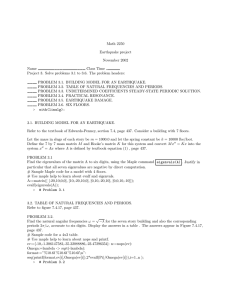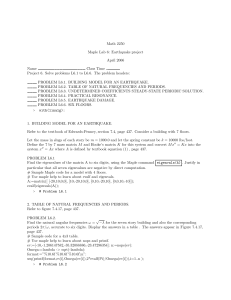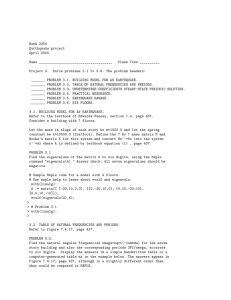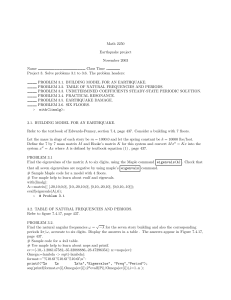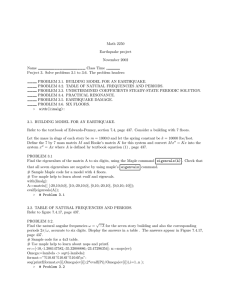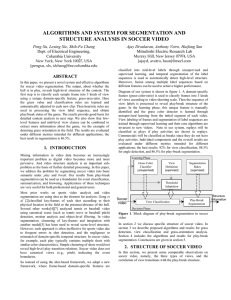Web-Pathology MEDSEM9 Sections and Descriptions ”off the web” July 2010
advertisement
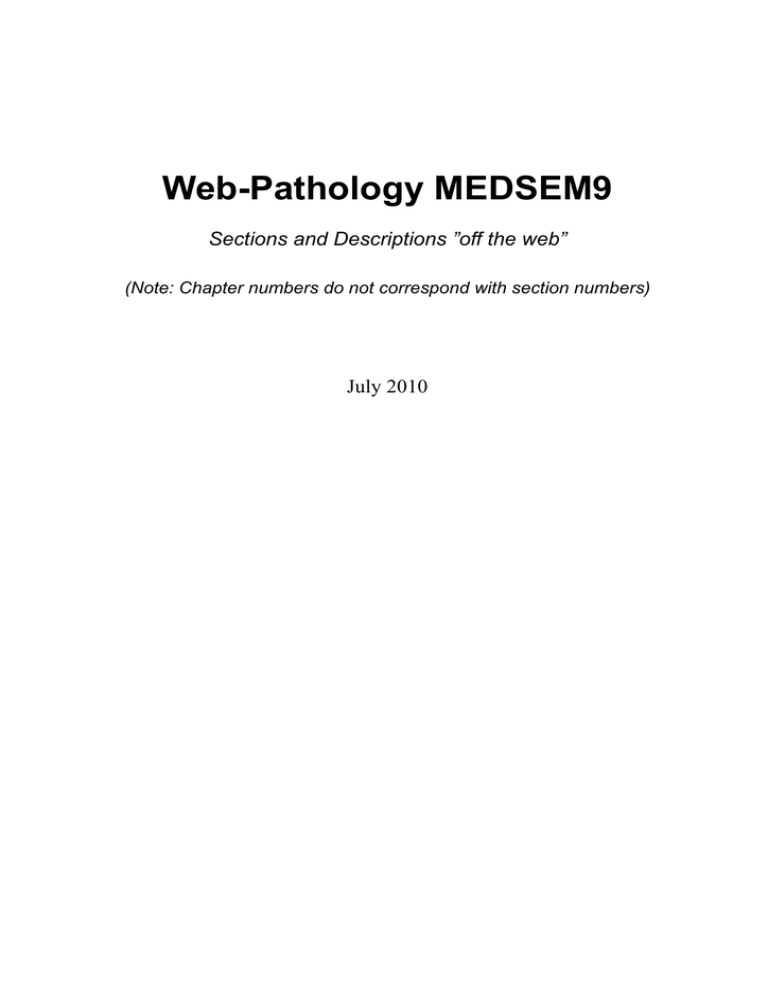
Web-Pathology MEDSEM9 Sections and Descriptions ”off the web” (Note: Chapter numbers do not correspond with section numbers) July 2010 2 List of Contents LIST OF CONTENTS .......................................................................................................................................... 2 CERVIX UTERI.................................................................................................................................................... 6 1. SQUAMOUS CELL DYSPLASIA............................................................................................................. 7 ZOOM-IN AREA 1.1 ................................................................................................................................ 7 1.1 1.2 ZOOM-IN AREAS 1.2 .............................................................................................................................. 9 1.2.1 Zoom-in area 1.2.1 .......................................................................................................................... 9 1.2.2 Zoom-in area 1.2.2 ........................................................................................................................ 10 DYSPLASIA AND KOILOCYTOSIS ..................................................................................................... 11 2. 2.1 ZOOM-IN AREA 2.1 .............................................................................................................................. 11 SQUAMOUS CELL CARCINOMA........................................................................................................ 13 3. 3.1 3.2 ZOOM-IN AREA 3.1 .............................................................................................................................. 13 ZOOM-IN AREA 3.2 .............................................................................................................................. 14 ENDOMETRIUM ............................................................................................................................................... 16 4. SIMPLE HYPERPLASIA ........................................................................................................................ 17 4.1 4.2 ZOOM-IN AREA 4.1 .............................................................................................................................. 17 ZOOM-IN AREA 4.2 .............................................................................................................................. 18 COMPLEX HYPERPLASIA ................................................................................................................... 20 5. ZOOM-IN AREAS 5.1 ............................................................................................................................ 20 5.1 5.1.1 Zoom-in area 5.1.1 ........................................................................................................................ 21 5.1.2 Zoom-in area 5.1.2 ........................................................................................................................ 22 5.1.2.1 Zoom-in area 5.1.2.1 .................................................................................................................................... 22 6. ADENOCARCINOMA – HIGHLY DIFFERENTIATED .................................................................... 24 ZOOM-IN AREAS 6.1 ............................................................................................................................ 24 6.1 6.1.1 Zoom-in area 6.1.1 ........................................................................................................................ 25 6.1.2 Zoom-in area 6.1.2 ........................................................................................................................ 26 ADENOCARCINOMA – POORLY DIFFERENTIATED ................................................................... 27 7. ZOOM-IN AREAS 7.1 ............................................................................................................................ 27 7.1 7.1.1 Zoom-in area 7.1.1 ........................................................................................................................ 28 7.1.2 Zoom-in area 7.1.2 ........................................................................................................................ 29 7.1.2.1 Zoom-in area 7.1.2.1 .................................................................................................................................... 30 8. ENDOMETRIOSIS ................................................................................................................................... 31 8.1 ZOOM-IN AREA 8.1 .............................................................................................................................. 32 MYOMETRIUM ................................................................................................................................................. 34 9. LEIOMYOMA ........................................................................................................................................... 35 9.1 9.2 10. 10.1 10.2 ZOOM-IN AREA 9.1 .............................................................................................................................. 36 ZOOM-IN AREA 9.2 .............................................................................................................................. 37 ADENOMYOSIS .................................................................................................................................. 38 ZOOM-IN AREA 10.1 ............................................................................................................................ 39 ZOOM-IN AREA 10.2 ............................................................................................................................ 41 OVARIES AND UTERINE TUBES .................................................................................................................. 42 3 11. CORPUS LUTEUM CYST.................................................................................................................. 43 ZOOM-IN AREAS 11.1.......................................................................................................................... 44 11.1 11.1.1 Zoom-in area 11.1.1 ................................................................................................................. 44 11.1.1.1 Zoom-in area 11.1.1.1 ................................................................................................................................ 45 11.1.2 11.1.3 Zoom-in area 11.1.2 ................................................................................................................. 46 Zoom-in area 11.1.3 ................................................................................................................. 47 POLYCYSTIC OVARIAN DISEASE ................................................................................................ 48 12. ZOOM-IN AREAS 12.1.......................................................................................................................... 49 12.1 12.1.1 Zoom-in area 12.1.1 ................................................................................................................. 49 12.1.2 Zoom-in area 12.1.2 ................................................................................................................. 50 SEROUS CYSTADENOMAS ............................................................................................................. 51 13. ZOOM-IN AREAS 13.1.......................................................................................................................... 52 13.1 13.1.1 Zoom-in area 13.1.1 ................................................................................................................. 52 13.1.2 Zoom-in area 13.1.2 ................................................................................................................. 53 13.1.2.1 Zoom-in area 13.1.2.1 ................................................................................................................................ 53 13.1.2.2 Zoom-in area 13.1.2.2 ................................................................................................................................ 54 14. MUCINOUS CYSTADENOMA ......................................................................................................... 56 14.1 14.2 ZOOM-IN AREA 14.1 ........................................................................................................................... 56 ZOOM-IN AREA 14.2 ........................................................................................................................... 57 PAPILLOMATOUS BORDERLINE TUMOR................................................................................. 59 15. 15.1 15.2 ZOOM-IN AREA 15.1 ........................................................................................................................... 59 ZOOM-IN AREA 15.2 ........................................................................................................................... 60 CYSTADENOCARCINOMA ............................................................................................................. 62 16. ZOOM-IN AREAS 16.1.......................................................................................................................... 63 16.1 16.1.1 Zoom-in area 16.1.1 ................................................................................................................. 63 16.1.2 Zoom-in area 16.1.2 ................................................................................................................. 64 16.1.3 Zoom-in area 16.1.3 ................................................................................................................. 65 16.1.3.1 Zoom-in area 16.1.3.1 ................................................................................................................................ 65 17. OVARY WITH BRENNER TUMOR ................................................................................................ 67 ZOOM-IN AREAS 17.1.......................................................................................................................... 68 17.1 17.1.1 Zoom-in area 17.1.1 ................................................................................................................. 68 17.1.2 Zoom-in area 17.1.2 ................................................................................................................. 69 17.1.2.1 Zoom-in area 17.1.2.1 ................................................................................................................................ 69 18. DERMOID CYST ................................................................................................................................. 71 ZOOM-IN AREA 18.1 ........................................................................................................................... 72 18.1 18.2 ZOOM-IN AREAS 18.2.......................................................................................................................... 73 18.2.1 Zoom-in area 18.2.1 ................................................................................................................. 73 18.2.2 Zoom-in area 18.2.2 ................................................................................................................. 74 18.2.3 Zoom-in area 18.2.3 ................................................................................................................. 75 18.2.4 Zoom-in area 18.2.4 ................................................................................................................. 76 18.2.5 Zoom-in area 18.2.5 ................................................................................................................. 77 MATURE TERATOMA ...................................................................................................................... 78 19. ZOOM-IN AREAS 19.1.......................................................................................................................... 79 19.1 19.1.1 Zoom-in area 19.1.1 ................................................................................................................. 80 19.1.1.1 Zoom-in areas 19.1.1.1 .............................................................................................................................. 81 19.1.2 Zoom-in area 19.1.2 ................................................................................................................. 83 19.1.2.1 Zoom-in area 19.1.2.1 ................................................................................................................................ 83 19.1.3 Zoom-in area 19.1.3 ................................................................................................................. 85 19.1.3.1 Zoom-in areas 19.1.3.1 .............................................................................................................................. 85 20. 20.1 GRANULOSA CELL TUMOR .......................................................................................................... 88 ZOOM-IN AREA 20.1 ........................................................................................................................... 89 4 20.2 ZOOM-IN AREA 20.2 ............................................................................................................................ 90 LEYDIG CELL TUMOR .................................................................................................................... 91 21. ZOOM-IN AREAS 21.1 .......................................................................................................................... 91 21.1 21.1.1 Zoom-in area 21.1.1 ................................................................................................................. 92 21.1.2 Zoom-in area 21.1.2 ................................................................................................................. 93 21.1.2.1 Zoom-in area 21.1.2.1 ................................................................................................................................ 93 PLACENTA ......................................................................................................................................................... 95 22. TUBAL PREGNANCY 1 ..................................................................................................................... 96 ZOOM-IN AREAS 22.1 .......................................................................................................................... 97 22.1 22.1.1 Zoom-in area 22.1.1 ................................................................................................................. 97 22.1.2 Zoom-in area 22.1.2 ................................................................................................................. 98 22.1.2.1 Zoom-in area 22.1.2.1 ................................................................................................................................ 98 23. TUBAL PREGNANCY 2 ................................................................................................................... 100 23.1 23.2 ZOOM-IN AREA 23.1 .......................................................................................................................... 100 ZOOM-IN AREA 23.2 .......................................................................................................................... 101 HYDATIFORM MOLE ..................................................................................................................... 103 24. 24.1 24.2 25. ZOOM-IN AREA 24.1 .......................................................................................................................... 103 ZOOM-IN AREA 24.2 .......................................................................................................................... 104 CHORIOCARCINOMA .................................................................................................................... 106 ZOOM-IN AREAS 25.1 ........................................................................................................................ 106 25.1 25.1.1 Zoom-in area 25.1.1 ............................................................................................................... 107 25.1.1.1 Zoom-in area 25.1.1.1 .............................................................................................................................. 107 25.1.2 Zoom-in area 25.1.2 ............................................................................................................... 109 25.1.2.1 Zoom-in area 25.1.2.1 .............................................................................................................................. 109 26. SEVERLY INFARCTED PLACENTA ............................................................................................ 111 ZOOM-IN AREAS 26.1 ........................................................................................................................ 111 26.1 26.1.1 Zoom-in area 26.1.1 ............................................................................................................... 112 26.1.1.1 Zoom-in areas 26.1.1.1 ............................................................................................................................. 112 26.1.2 Zoom-in area 26.1.2 ............................................................................................................... 115 TESTIS ............................................................................................................................................................... 116 27. SEVERE ATHROPHY ...................................................................................................................... 117 ZOOM-IN AREAS 27.1 ........................................................................................................................ 117 27.1 27.1.1 Zoom-in area 27.1.1 ............................................................................................................... 118 27.1.2 Zoom-in area 27.1.2 ............................................................................................................... 119 MALIGNANT TESTICULAR TUMOR .......................................................................................... 120 28. ZOOM-IN AREAS 28.1 ........................................................................................................................ 121 28.1 28.1.1 Zoom-in area 28.1.1 ............................................................................................................... 121 28.1.2 Zoom-in area 28.1.2 ............................................................................................................... 122 28.1.2.1 Zoom-in area 28.1.2.1 .............................................................................................................................. 122 29. EXTIRPATED TESTIS WITH SEMINOMA ................................................................................. 124 29.1 29.2 ZOOM-IN AREA 29.1 .......................................................................................................................... 125 ZOOM-IN AREA 29.2 .......................................................................................................................... 126 PATHOLOGY IN CHILDHOOD ................................................................................................................... 127 30. NEUROBLASTOMA ......................................................................................................................... 128 ZOOM-IN AREAS 30.1 ........................................................................................................................ 128 30.1 30.1.1 Zoom-in area 30.1.1 ............................................................................................................... 129 30.1.1.1 Zoom-in area 30.1.1.1 .............................................................................................................................. 129 30.1.2 Zoom-in area 30.1.2 ............................................................................................................... 131 5 30.1.3 31. Zoom-in area 30.1.3 ............................................................................................................... 132 HEPATOBLASTOMA ...................................................................................................................... 133 ZOOM-IN AREAS 31.1........................................................................................................................ 133 31.1 31.1.1 Zoom-in area 31.1.1 ............................................................................................................... 134 31.1.1.1 Zoom-in areas 31.1.1.1 ............................................................................................................................ 134 31.1.2 31.1.3 31.1.4 Zoom-in area 31.1.1.2 ............................................................................................................ 137 Zoom-in area 31.1.3 ............................................................................................................... 138 Zoom-in area 31.1.4 ............................................................................................................... 139 31.1.4.1 Zoom-in area 31.1.4.1 .............................................................................................................................. 139 32. NEPHROBLASTOMA ...................................................................................................................... 141 ZOOM-IN AREAS 32.1........................................................................................................................ 141 32.1 32.1.1 Zoom-in area 32.1.1 ............................................................................................................... 142 32.1.1.1 Zoom-in area 32.1.1.1 .............................................................................................................................. 142 32.1.2 33. Zoom-in area 32.1.2 ............................................................................................................... 144 RESPIRATORY DISTRESS SYNDROME .................................................................................... 145 ZOOM-IN AREAS 33.1........................................................................................................................ 146 33.1 33.1.1 Zoom-in area 33.1.1 ............................................................................................................... 147 33.1.2 Zoom-in area 33.1.2 ............................................................................................................... 148 34. CYSTIC RENAL DYSPLASIA ........................................................................................................ 149 ZOOM-IN AREA 34.1 ......................................................................................................................... 150 34.1 34.2 ZOOM-IN AREAS 34.2........................................................................................................................ 151 34.2.1 Zoom-in area 34.2.1 ............................................................................................................... 151 34.2.2 Zoom-in area 34.2.2 ............................................................................................................... 152 34.2.3 Zoom-in area 34.2.3 ............................................................................................................... 153 6 CERVIX UTERI 7 1. Squamous cell dysplasia Patient history: 43 year-old female, in whom repeated examination has shown areas of dysplasia in cervicovaginal smears. Confimation was obtained with a cervical biopsy displaying severe dysplasia (CIN III). As a result of this diagnosis a conization was perfomed. The transition between the surface of the portio cervicis uteri and the cervical canal is seen in the middle of the image. Question 1: Which tissue compounds do you recognize? - see arrows 1.1 Zoom-in area 1.1 8 In this image we have magnified the transistion zone between the squamous epithelium of the portio and the cylindrical epithelium of the cervical canal. Question 1: Describe the differences between the squamous epithelium you see here and normal squamous epithelium. - The squamous epithelium lacks the normal stratification towards the surface with maturation of cells to large squames. The nuclear/cytoplasmic ratio is high towards the surface with basal like cells. Question 2: What do we call this type of epithelial change? - High grade dysplasia or carcinoma in situ. Question 3: What type of thange does usually occur in the cylindrical epithelium before such changes occur? - The cylindrical epithelium of the cervical canal undergoes metaplasia to mature squamous epithelium in the transitional zone. Thereafter the epithelium displays low- and high grade dysplasia primary to these lesions turning into infiltrating carcinoma. 9 1.2 Zoom-in areas 1.2 1.2.1 Zoom-in area 1.2.1 This is a closeup of the epithelium with high grade dysplasia (carcinoma in situ). Question 1: What kind of changes does the epithelium display? - The cells of the epithelium display atypia, increased nuclear/cytoplasmic ratio, pleomorphism, intercellular variation in shape and size, and an increased number of mitoses 10 which are seen some distance from the basal layer (mitioses are normally seen in the basal layer only). 1.2.2 Zoom-in area 1.2.2 11 2. Dysplasia and koilocytosis Patient history: 34 year-old female with a previously shown severe dysplasia in a cervicovaginal cytological investigation, now with a pappillomatous growths on the protio that have been biopsied with suspicion of dysplasia. Question 1: Which tissue elements do you see in this biopsy from the cervix? - see name tags 2.1 Zoom-in area 2.1 12 Question 1: Which changes do you see in the epithelium? - It shows moderate dysplasia with immature cells (high nuclear/cytoplasmic ratio in the lower 2/3 of the epithelium (below the line)) and koilocytotic cells due to the HPV affection at the surface. 13 3. Squamous cell carcinoma Patient history: 44 year-old female with a known dysplasia of cervical epithelial cells, demonstrated in both a cytological sample and a biopsy of the cervix. Based on these findings, a conization was performed. Question 1: Where is the border between the squamous cell carcionoma of the portio and the stroma? - see line 3.1 Zoom-in area 3.1 14 At this magnification the border between the tumor and the stroma is easier to spot. Question 1: Indicate the infiltrating strands of tumorcells and the retained dysplastic mucosa? - see the line Question 2: Where are the hornpearls that show that this is a keratinizing squamous carcinoma? - see arrows 3.2 Zoom-in area 3.2 15 At the highest magnification we get a closeup of the interphase between the tumor and the stroma. Question 1: What cells do you see here? - Leukocytes; that is lymphocytes and macrophages 16 ENDOMETRIUM 17 4. Simple hyperplasia Patient history: 46 year-old female with metrorrhagia and known myoma of the uterus. As a result, a supravaginal uterus amputation was performed. Gross appearance showed a supravaginally amputatded uterus and adnexes. A myomatous nodule, 7 cm in diameter, was identified in the myometrium. Section from the endometrium for histological investigation. The image to the left represents a low power micrograph of the the curratage material. Glands of various sizes are seen (circular structures). 4.1 Zoom-in area 4.1 18 The smaller glands represents normal glands during the normal proliferative phase. The larger ones show coniderable dilation with an uneven configuration and pseudostratified epithelium (hard to see in this image because of the low resolutiuon of this computer image, but try to magnify). 4.2 Zoom-in area 4.2 19 Question 1: What is the diagnosis? - Endometruin with simple hyperplasia without atypia and with metaplasia (the metaplasia is not diplayed in the image to the left, so if you didn't think of that it doesn't matter). In simple hyperplasia without atypia (this section), there is proliferation of cells, but the basic structure of the endometrium is relatively unchanged. This is considered to be the least dangerous type of hyperplasia. Other terms that are approximately the same as simple hyperplasia are mild, cystic, or Swiss-cheese hyperplasia. Question 2: What other disorders can cause these kind of changes to the endometrium? - anovalatory cycles, obesity, diabetes mellitus type II, hypertention and granulosacell tumor. The take home message is that the gland is under influence by estrogen over longer periods of time and gets hyperplastic. 20 5. Complex hyperplasia Patient history: 46 year-old female with metrorrhagia and known myoma of the uterus. As a result, a supravaginal uterus amputation was performed. The image to the left reveals a section through the uterine wall with an endometrium that includes areas with proliferating glands. One can see en area with closely situated, irregular glands lacking intervening connective tissue and partially including cribriform glandular tissue. 5.1 Zoom-in areas 5.1 21 5.1.1 Zoom-in area 5.1.1 These are normal glands in comparison. Question 1: In what phase is the endometrium? - it's in the proliferative phase. 22 5.1.2 Zoom-in area 5.1.2 The epithelium is to some extent pseudostratified and several mitoses are present. There is no atypia, although there is some degree of nuclear variation. There are many areas with squamous cell metaplasia (might be hard to see in this computer image). Question 1: Why is the ratio of epithelial cells to stroma so high? - Because the epithelial cells divide more rapidly under the influence of prolonged estrogen stimulation. The gland folds and twists and get their caracteristic look as seen in this image. The lack of stroma makes the gland laying "back-to-back". Question 2: What clinical conditions is associated with complex hyperplasia? - Anovularory cycles, obesity, granulosacell tumor 5.1.2.1 Zoom-in area 5.1.2.1 23 The metaplasia is seen in the middle of this image and is represented by columnar (gland) epithelium that has turned into areas of squamous epithelium. Question 1: Define metaplasia (any organ)? - it's the reversible replacement of one differentiated cell type with another mature differentiated cell type. Question 2: Name at least two other examples of metaplasia in other organs and their cause: a) Oesophagus: - replacement of squamous epithelium by columnar epithelium because of gastro-esophageal reflux b) The bladder - replacement of transitional epithelium by squamous epithelium caused by bladder stone c) Airways: - replacement of Columnar epithelium with Squamous epithelium caused by Cigarette smoke 24 6. Adenocarcinoma – highly differentiated Patient history: 40 year-old female with irregular menstrual bleeding during the last 6 months. Cutterage showed adenocarsinoma upon histological examination. Admitted to hospital for removal of the uterus. The image is a low power migrograph of endometrium and adjacent myometrium showing a well differentiated adenocarcinoma. Question 1: Indicate the border between the two tissue components? - see the line Question 2: What kind of pathological change does the endometrium show? - The endometrium is thicker than normal and displays atypical glands consistent with endometrial adenocarcinoma. Because you can see well developed glands, albeit atypical, the tumor is graded as a well differentiated adenocarcinoma. Because there is no infiltration into the myometrium, the tumor is classified as an adenocarcionoma in situ or intramucosal adenocarcinoma. 6.1 Zoom-in areas 6.1 25 6.1.1 Zoom-in area 6.1.1 Question 1: What are the two dominating pathological features in this medium powered micrograph? - atypical glands filled with granulocytes (neutrophils) 26 6.1.2 Zoom-in area 6.1.2 This is a medium power micrograph of the border area between the adenocarcionoma and the basal layer of the normal endometrium. Question 1: Indicate the actual border between the two tissue components. - see the line Question 2: What characterizes the glands of the adenocarcionoma? - The glands show an increased variation in shape and are located "back to back" without intervening stroma as opposed to the precence of stroma between the normal gland to the right in the micrograph. The glandular structures seen in the adenocarcionoma in situ are similar to those seen in complex hyperplasias. Question 3: Is this a poorly or higly differentiated adenocarcionoma and why? - its' highly differentiated because of the glandular structure. A poorly differentiated tumor would display very little or no glandular structure (no lumen). 27 7. Adenocarcinoma – poorly differentiated Patient history: 89 year-old female with hypertension and cystocele. Utereine bleeding over several months. Admitted to the outpatient clinic for abrasio mucosa uteri. This is a low power micrograph of a poorly differentiated endometrial adenocarcinoma. Question 1: Indicate the border between the tumor and the myometrium. 7.1 Zoom-in areas 7.1 28 7.1.1 Zoom-in area 7.1.1 Another medium power field of vision showing gland-like clefts in the tumor also exhibing papillary growth. Question 1: Identify the tumor areas, the papillary component as well as the myometrium through which the tumor infiltrates. - see arrows 29 7.1.2 Zoom-in area 7.1.2 This medium power micrograph illustrates the border between the infiltrating adenocarcionoma and myometrium. Question 1: Identify the infiltrating strands of tumor and the interposing myometrium. - see arrows Question 2: What characterizes a poorly differentiated adenocarcinoma? - A poorly differentiated adenocarcionoma is mainly made up by solid sheets and strands of atypical cells forming only a very limited number of glands. Question 3: What is the diagnosis? - Uterine wall with infiltration of poorly differentiated endometrial adenocarcionoma (do you want to see the well differentiated adenocarcionoma again?) 30 7.1.2.1 Zoom-in area 7.1.2.1 31 8. Endometriosis Patient history: 33 year-old female with periodic pain in the area of scar following Cecarean section. The scar was removed and a section taken for histological examination. This is a low power micrograph of the scar tissue taken from the abdominal wall. Question 1: Identify and describe the unexpected components in the tissue. - Glandular structures, partly cystically dialated (see arrows) 32 8.1 Zoom-in area 8.1 Medium power micrograph of endometrial glands surrounded by connective tissue (endometriosis). Question 1: Describe 3 mechanisms by which connective tissue can be misplaced into abdominal wall connective tissue as well as distant organs. 33 1 - Through direct contamination of endometrium into a cecerean woundbed. 2 - Regurgitation through the Fallopian tube by retrograde menstruation (endometriosis in ovaries, ligaments). 3 - Lympho- or hematogeneously through vessels to distant organs. 34 MYOMETRIUM 35 9. Leiomyoma This is a low power micrograph of a uterine leiomyoma. Question 1: What is a leiomyoma? - Leiomyoma is a benign neoplasia composed of bundles of smooth muscle cells, and is seen in the myometrium of about 25% of women in active reproductive life Question 2: Outline the boundry between the laiomyoma and the myometrium. - see line. Question 3: Uterine leiomyomas are often classified according to it's position within the uterine wall. What are the three subtypes and which type do you see here? - Intramural, submocosal and subserosal leiomyomas. The one seen here is an intramural leiomyoma because it is located in the middle of the myometrium without contact with the serosa or the mucosa. 36 9.1 Zoom-in area 9.1 Medium power micrograph of the border area. Question 1: Identify the actual border between the leiomyoma and the myometrium. - see line Question 2: Describe the discriminating histological features between the leiomyoma and the normal myometrium. - The leiomyoma is composed of bundles of muscle cells running in a criss-cross pattern, whereas larger bundles running in paralell characterize the myometrium. 37 9.2 Zoom-in area 9.2 High power magnification of the leiomyoma. Question 1: Describe the histological feautures of the smooth muscle cells. - The muscle cells are uniform in size with slender bipolar cytoplasma and oval sigarshaped nuclei with granular chromatin (see arrows). Mitosis are virtually absent. 38 10. Adenomyosis Patient history: 58 year-old woman diagnosed with rectal adenocarcinoma that was treated with rectal resection. It was also simultaneously perfomed hystero-salping-oophorectomy. The image is a low power micrograph of the myometrium. Question 1: Identify two kinds of pathological features. - The myometrium has a nodular appearance (stipled lines) and dialated cysts, consistent with adenomyosis (arrows), i.e. endometrial glands displaced into the myometrium. 39 10.1 Zoom-in area 10.1 40 Medium power micrograph of some dialated glands in a myometrial nodule. The glands are surrounded partly by endometrial stroma. Question 1: Identify these areas and see if you can find the border between the nodule and myometrium. - see the line 41 10.2 Zoom-in area 10.2 High power micrograph of an endometrial gland with surrounding stroma. Question 1: What type of epithelium is this gland made up of? - The epithelium is cylindrical and singlelayered. Question 2: How do you distinguish the stroma from smooth muscle tissue? - The nuclei cannot be distinguished from those of myocytes, but the collagen fibres between the cells are different from myofibrils. 42 OVARIES AND UTERINE TUBES 43 11. Corpus luteum cyst Patient history: During a kidney transplant operation, a cyst was found in the left ovary. The ovary with the cyst was extirpated. The image is a low power micrograph of the ovary with parts of the wall of a large cyst and a smaller cyst in the cortex ovary. Question 1: Indicate the wall of the larger cyst, the small cyst and the cortex ovary. - see the arrows Question 2: What type of cyst do you see in the cortex? - a tertiary follicle 44 11.1 Zoom-in areas 11.1 11.1.1 Zoom-in area 11.1.1 This is a medium power micrograph of the larger cyst. Question: what characterizes the lining of the cyst? - The lining is multilayered by cells rich in eosinophilic cytoplasm. 45 11.1.1.1 Zoom-in area 11.1.1.1 This is a high power micrograph of the lining of a corpus luteum cyst. Question: How would you describe the cells? - The cells are luteinized follicular cells with abundant eosinophilic cytoplasm and round nuclei that may be excentrically located, often containing nucleoli. These cells typically have a lower nuclear/cytoplasmic ratio than follicular cells, from which they develop. Some cells have empty cytoplasm due to loss of lipids through processing. Click here if you want to se a normal corpus luteum. 46 11.1.2 Zoom-in area 11.1.2 This is a high power micrograph of a tertiary follicle in the ovarian cortex. Task: name the various structures of the follicle. - see arrows 47 11.1.3 Zoom-in area 11.1.3 This is a high power micrograph of the normal cortex ovary. Question: Which typical features do you see? - there are primordial follicles surrounded by the typical ovarian stroma with a criss-cross pattern of collagen bundles. 48 12. Polycystic ovarian disease Patient history: 39 year-old female, undergoing in vitro fertilization (IVF) treatment for infertility. Ultrasonic examination showed bilateral polycystic ovaries. A wedge resection of both ovaries was performed and a section from the left ovary was taken for histological examination. This image is a low power micrograph of the polycystic ovary. The cystically dialated follicles located mainly in the cortex, and the secondary follicles directly under the surface are pintet out in the image. 49 12.1 Zoom-in areas 12.1 12.1.1 Zoom-in area 12.1.1 This is a high power micrograph of the normal ovarian cortex with primordial follicles and part of the wall of the follicular cyst. 50 12.1.2 Zoom-in area 12.1.2 This high power micrograph shows the walls of the follicular cyst in higher detail. Question: can you describe the lining of the cyst? - The lining consists of several layers of follicular cells with a rather high nuclear/cytoplasmic ratio (scanty cytoplasma). Compare with the corpus luteum cyst. 51 13. Serous cystadenomas Patient history: 73 year-old female with a cyst in the right ovary. The cyst and a portion of the uterine tube were removed and a section was taken for histological examination. This is a low power micrograph of the ovarian cyst with two chambers. Question: What is defining the type of cyst we see? - the inner surface layer of the cyst 52 13.1 Zoom-in areas 13.1 13.1.1 Zoom-in area 13.1.1 This high power micrograph of the cyst wall shows typical cortical stroma. The cells covering the cyst wall are so flattened that their type cannot be determined. 53 13.1.2 Zoom-in area 13.1.2 This image is a high power micrograph of the two chambers of the cyst. An epithelial lining is indicated to the left. 13.1.2.1 Zoom-in area 13.1.2.1 54 This is a high power micrograph of the cyst wall. The surface epithelium can be seen to the left. Question: What type of epithelium is this, and what type of cyst is this? - the cyst is covered by a cylindrical serous type of epithelium and because of this, it is a serous cystadenoma. This is the same type of epithelium you would find on the inner surface of the fallopian tube. 13.1.2.2 Zoom-in area 13.1.2.2 55 56 14. Mucinous cystadenoma Patient history: 33 year-old female with a cystic mass in the right ovary. An oophorectomy on the side was perfomed. This is a low power micrograph of the folded wall of an ovarian cyst. The surface epithelium of the cyst wall is defining the type of cyst. Question: Can you indicate the cyst surface? - see arrows that indicate tha cyst surface. 14.1 Zoom-in area 14.1 57 Medium power micrograph of the cyst wall. Question: What type of epithelium is lining the wall? - It is a one-layered regular cylindrical epithelium. 14.2 Zoom-in area 14.2 58 High power micrograph of the epithelial lining of the cyst. Question 1: What type of epithelium is this? - We have a one- layered regular mucinous epithelium that is found normally in the mucinous glands of the uterine cervix. The nuclei are typically pushed to the basal part of the cells by the mucin. Question 2: What type of cyst do we have? - The cyst is a mucinous cystadenoma of the ovary. Question 3: What is the assumed pathogenesis for development of both serous and mucinous cysts in the ovary? - The ovaries are lined by a special type of serosa (mesothelium) that is also called “coelomic epithelium”. That means that it may easily be transformed to epithelium through metaplasia when it is trapped in the woundbed after rupture of the follicle during ovulation. Cysts may then develop with either serous or mucinous epithelium. 59 15. Papillomatous borderline tumor Patient history: 55 year-old with a mass in the right flank (regio lateralis dextra), shown upon ultrasound examination to be a large cyst measuring 20x20x16 cm and weighing 1,8kg. The cyst is removed along with the entire right ovary. This is a low power micrograph of the inner surface of the ovarian cyst with papillary outgrowths (excrescences) 15.1 Zoom-in area 15.1 60 This medium power micrograph shows that thicker fibrous septa is branching into smaller septa and there is no sign of tumor infiltration into the stroma. 15.2 Zoom-in area 15.2 61 The high power microphotograph is showing that the papillary epithelium is irregular and stratified with atypical cells compared to those seen in serous cystadenomas. Papillary projections with multilayered, atypical epithelium without stromal infiltration is typical of tumors with borderline malignancy. 62 16. Cystadenocarcinoma Patient history: 63 year-old female with an abnormal tumor approx. 3 cm in diameter, severe ascites, discovered as a coincidental finding. Removal of the tumor and ovary was accomplished by a supravaginal uterus amputation. Parts of the omentum majus were resected. This low power micrograph of the ovary is showing the surface with its papillary tumor growth. The tumor tissue is seen infiltrating the ovarian stroma and cyst formation with partly papillary growth pattern. Question 1: Why does this patient present with ascites? - the ascites in this case represents a serous liquid prodused by tumor cells in the abdominal cavity. 63 16.1 Zoom-in areas 16.1 16.1.1 Zoom-in area 16.1.1 This medium power micrograph shows papillary tumor growth on the surface of the ovary and the tumor infiltrating in the stroma. 64 16.1.2 Zoom-in area 16.1.2 This image displays papillary tumor infiltration within the stroma. 65 16.1.3 Zoom-in area 16.1.3 In this image you can see papillary growth of the tumor and stratified layers of tumor cells covering the surface. 16.1.3.1 Zoom-in area 16.1.3.1 66 This high power micrograph is showing multilayered highly atypical tumor cells with two mitotic figures. Try to identify these cells. 67 17. Ovary with brenner tumor Patient history: 58 year-old woman that previously was hysterectomized. Now a cystic tumor of the right ovary was detected by CT. A bilateral oophorectomy was performed. This low power micrograph shows ovarian stroma upper left and neoplastic tissue in the lower part, separated from normal ovarian stroma by a fibrous capsule (see labelling by hitting '?'). Question: Which components does the tumor tissue consist of? - The neoplasm consists of epithelial nests embedded in fibrous stroma (see labelling). 68 17.1 Zoom-in areas 17.1 17.1.1 Zoom-in area 17.1.1 This image shows with high power magnification normal ovarian stroma (in comparison). 69 17.1.2 Zoom-in area 17.1.2 This medium power micrograph shows some more details of the epithelial nests surrounded by a fibrous stroma. 17.1.2.1 Zoom-in area 17.1.2.1 70 This image displays the epithelial nests with great detail. Question 1: How would you describe the epithelial cells in these nests? - The epithelial cells have regular round-oval nucleii with medium amount of cytoplasm and show a stratified arrangment. The epithelium have a morphology similar to urothelial (transitional ) cells. Question 2: Based on the morphology of these tumor cells, how would you judge the malignancy potential of the neoplasm? - The cells are regular without atypia and mitosis consisten with benign phenotype. Most of these tumors are benign. 71 18. Dermoid cyst Patient history: 33 year-old female with a cyst in the right ovary, diagnosed upon gynecological examination. Right ovary and cyst were removed. This is a low power micrograph showing parts of the inner cyst wall with verrucous epithelial lining with hyperkeratosis and fat tissue (see labeling by pressing '?'). Imagine the verrucous part seen in this image protruding into the cyst. The ovarian stroma is seen on the bottom of the image. Question 1: Why is it then that we call this a dermoid cyst? - a cyst is defined by the epithelium that covers it's inner surface. In this case it's covered by papillary protrutions of epidermis (like your skin or dermis), hence a dermoid cyst. On higher magnification you can also see the basal- and granular layer of the epidermis. 72 18.1 Zoom-in area 18.1 This magnification is medium power micrograph of structures typical of skin. Question 1: What does the professor mean when saying he can see epidermis with its adnexal strutures? - that he sees structures normally found in connection to the epidermis, like hairfollicles, sweat glands, and sebaceous glands. Describe these structures in the high power microphotographs (press the 'magnifying glass' button). 73 18.2 Zoom-in areas 18.2 18.2.1 Zoom-in area 18.2.1 74 18.2.2 Zoom-in area 18.2.2 75 18.2.3 Zoom-in area 18.2.3 76 18.2.4 Zoom-in area 18.2.4 77 18.2.5 Zoom-in area 18.2.5 78 19. Mature teratoma Patient history: 18 year-old female with abdominal pain on the right side. Removal of ovarian tumor on the right side. No suspicion of peritoneal glimatoris, negative for alphafetoprotein (AFP). This is a low power micrograph of parts of the extirpated ovarian tumor. We see a solid area, one cyst and parts of a cystic lesion. 79 19.1 Zoom-in areas 19.1 80 19.1.1 Zoom-in area 19.1.1 This is a medium power magnification of the mucosal surface and eosinophilic bundles of connective tissue. Question: Describe these structures in the high power microphotographs. - The mucosa shows foveolar surface covering underlying glands typical of gastric mucosa with chief and parietal cells. The eosinofilic bundles are smooth muscle representing the gastric wall. Conclusion: We have thus representation of mature tissues from all three germ layers (ectomeso- and endoderm) typical of a benign teratoma. 81 19.1.1.1 Zoom-in areas 19.1.1.1 19.1.1.1.1 Zoom-in area 19.1.1.1.1 82 19.1.1.1.2 Zoom-in area 19.1.1.1.2 83 19.1.2 Zoom-in area 19.1.2 This is a medium power magnification of connective tissue with some inflammation in the upper and middle part, whereas eosinophilic (red) tissue is seen at the bottom left. Question: Describe the eosinophilic tissue in the high power microphotograph. - This is tissue resembles CNS tissue, that is brain tissue, with bundles of neurofibrils and astrocytes (see labels). 19.1.2.1 Zoom-in area 19.1.2.1 84 85 19.1.3 Zoom-in area 19.1.3 This is a medium power magnification the epithelial lining of the cyst and the adjacent fatty tissue. Question: Describe the epithelial lining of the cyst by using high power magnification. - A cornified squamous epithelium is seen (epidermal surface), with basal, spinous, granular and cornified layers. See indications on the microphotograph. 19.1.3.1 Zoom-in areas 19.1.3.1 86 19.1.3.1.1 Zoom-in area 19.1.3.1.1 87 19.1.3.1.2 Zoom-in area 19.1.3.1.2 88 20. Granulosa cell tumor Patient history: 62 year-old female, underwent menopause in 1992. In 1996, a curettage from the uterus showed simple cystic hyperplasia. Recurrent, light uterine bleeding. Biopsy from the endometrium in 1999 showed complex hyperplasia with atypia. A tumor was diagnosed in the right adnex, including polyps in the uterus. The uterus was extirpated with the tubes and ovaries. This power magnification shows part of the ovary with a demarcated nodule under the cortex. 89 20.1 Zoom-in area 20.1 90 20.2 Zoom-in area 20.2 Try to describe the tissue. Question 1: What type of neoplasm could the nodule represent? - The tissue is made up of cells with relatively scanty cytoplam that lie closer together than eg the fibroblasts of the cortical stroma. The cells contain round to oval nuclei occationally demonstrating a midline furrow. Glands or mitosis are not seen.This is a granulosa cell tumor of the adult type, and a representative of ovarian stromal tumors. 91 21. Leydig cell tumor Patient history: 57 year-old female with increasing hair growth and elevated testosterone levels. Clinical suspicion of testosterone-producing ovarian tumor. Laprascopy showed a somewhat enlarged left ovary, wich was therefore removed. This low power microphotograph shows the ovarian cortex with a corpus albicans and a subcortical tumormass with some cystic lumina, se labelling. 21.1 Zoom-in areas 21.1 92 21.1.1 Zoom-in area 21.1.1 This medium power magnification shows the typical stroma of the ovarian cortex with parts of the corpus albicans with the transition to subcortical tumor tissue. 93 21.1.2 Zoom-in area 21.1.2 This image shows the tumor tissue with some cystic spaces. 21.1.2.1 Zoom-in area 21.1.2.1 94 Question 1: Describe the tumor cells and suggest the type of neoplasia: - The neoplastic cells show abundant eosinophilic cytoplasm and have round nucleii with a distinct nucleolus. The nucleii are often exentrically located. Mitosis or glandlike structures are not seen. The cells have a morphology which resembles Leydig cells in the interstitium of testestis, and the tumor is a Leydig cell tumor, another representative of stromal or sex cord tumors of the ovary. 95 PLACENTA 96 22. Tubal pregnancy 1 Patient history: 32 year-old woman with abdominal pain and uterine bleeding with clinical suspicion of an ectopic pregnancy. Surgery was performed and a thickened, bleeding left tube was removed. This is a low power micrograph showing the Fallopian tube with hemorrhage and immature placental villi in the tubal wall. 97 22.1 Zoom-in areas 22.1 22.1.1 Zoom-in area 22.1.1 98 22.1.2 Zoom-in area 22.1.2 22.1.2.1 Zoom-in area 22.1.2.1 99 100 23. Tubal pregnancy 2 23.1 Zoom-in area 23.1 101 23.2 Zoom-in area 23.2 102 103 24. Hydatiform mole Patient history: 38 year-old female, in the 14th week of pregnancy. Ultrasound investigation created suspicion of hydatiform mole and a uterine evaculation was performed. 24.1 Zoom-in area 24.1 104 24.2 Zoom-in area 24.2 105 106 25. Choriocarcinoma Patient history: 29 year-old female with persistent bleeding following a spontaneous abortion. Cutterage showed malignant throphoblastic proliferation. The patient was treated with chemotherapy for four months, but a relapse was detected mafter trhee months. As a result, the uterus was removed. 25.1 Zoom-in areas 25.1 107 25.1.1 Zoom-in area 25.1.1 25.1.1.1 Zoom-in area 25.1.1.1 108 109 25.1.2 Zoom-in area 25.1.2 25.1.2.1 Zoom-in area 25.1.2.1 110 111 26. Severly infarcted placenta Patient history: 31 year-old female admitted to the hospitale due to severe pre-eclampsia. She was treated with pressure-lowering medications (Aldomed and Trandate). Three week later no fetal sound was audible. This is a low power micrograph showing normal placental tissue to the right, and mainly infarced placental tissue to the left. Try to indicate areas of normal and infarcted placental tissues, respectively. 26.1 Zoom-in areas 26.1 112 26.1.1 Zoom-in area 26.1.1 26.1.1.1 Zoom-in areas 26.1.1.1 113 26.1.1.1.1 Zoom-in area 26.1.1.1.1 114 26.1.1.1.2 Zoom-in area 26.1.1.1.2 115 26.1.2 Zoom-in area 26.1.2 This high power magnification relatively mature placental villi. Question: What characterizes such villi? 116 TESTIS 117 27. Severe athrophy Patient history: 44 year-old male with longstadning, left sided varicocele and diminished size of the left testis, which was removed. 27.1 Zoom-in areas 27.1 118 27.1.1 Zoom-in area 27.1.1 119 27.1.2 Zoom-in area 27.1.2 120 28. Malignant testicular tumor Patient history: 39 year-old male with tumor in the right testis, upon a coincidentally finding. Ultrasound investigation gave suspicion of a malignant testicular tumor. With low power magnification we see a section with testicular tissue and neoplastic tissue. Question 1: Can you see the different tissue components (testicular tissue, tunica albuginea and neoplastic tissue)? - see arrows 121 28.1 Zoom-in areas 28.1 28.1.1 Zoom-in area 28.1.1 This image shows a medium power magnification of the testicular tissue. Question 1: How would you describe the testicular tisuue, and indicate where you see Leydig cells. 122 - There is testicular atrophy with reduced spermatogenesis and reduced cell density with mainly spermatogonia and Sertoli cells along with some few spermatocytes in the lumen of seminiferous tubules. Haploid cells such as spermatids and spermatozoa are lacking. The Leydig cells are in the interstitium between the tubules (see arrows). 28.1.2 Zoom-in area 28.1.2 28.1.2.1 Zoom-in area 28.1.2.1 123 124 29. Extirpated testis with seminoma Patient history: 31 year-old male with a coinidentally discovered enlarged left testis. He was admitted for removal of the testis due to suspicions of a malignant tumor. Verification from a frozen section. This low power micrograph shows testicular tissue with a neoplasm. Question 1: Try to indicate the tunica albuginea, testicular tissue and the neoplasm. - see arrows 125 29.1 Zoom-in area 29.1 126 29.2 Zoom-in area 29.2 127 PATHOLOGY IN CHILDHOOD 128 30. Neuroblastoma Patient history: An 8 year-old girl with incerasing pain in her back, legs and pubic region. A large abdominal tumor located between the right kidney and her liver was discovered. Xray showed affection of the skeleton. After trhee months og chemotherapy aimed at reducing the size of the tumor, removal of the right adrenal gland and tumor was attempted. This is a low power micrograph of the right adrenal with a neuroblastoma after cytotostatic treatment for 3 months, to reduce tumor size and make surgery possible. Question: Where is the rest of the normal adrenal located, and where is the neoplasm? - See the indications made on the illustration. 30.1 Zoom-in areas 30.1 129 30.1.1 Zoom-in area 30.1.1 30.1.1.1 Zoom-in area 30.1.1.1 130 This image shows the neoplastic tissue with high power magnification. Question: How would you characterize the tumor cell nuclei, and which other feature is typical of neuroblastomas? - The tumor cell nuclei are atypical and pleomorphic, that means they are different from normal neuroblasts (atypical), and show differences among each other in nuclear size and shape (pleomorphic). There is a varying amounts of neurofilaments. 131 30.1.2 Zoom-in area 30.1.2 This image shows a medium power micrograph of the neoplasm with areas of fibroses due to preoperativ treatment. Question: Where is the fibrosis, and why has it developped? - Location of fibrosis is indicated in the image. Chemotherapy has induced tumorcell death and the necrosis of cells following the chemotherapy has been replaced by fibrosis. 132 30.1.3 Zoom-in area 30.1.3 This image shows a medium power micrograph of the rest of the adrenal cortex. Due to treatment there is a disruption of the architexture of the middle zone of the cortex. Question: What do we call these three zones, and why do the cells show an empty cytoplasm? - The zones are from the capsule to the medulla: zona glomerulosa, zona fasciculata (the fascicular formation is disrupted) and the zona reticularis. The cells have an empty cytoplasm because their lipid content has been washed out by the preparation precedure (lipid soluble chemicals). 133 31. Hepatoblastoma Patient history: 3 year-old girl with previously known enlarged liver and abdominal pain. Fine-needle aspiration showed hepatoblastoma. Having been treated with chemotherapy for tumor reduction, resection of the tumor and portions of the liver was undertaken. This is a low power image of the resected specimen. You can see non-neoplastic liver tissue to the right side. The rest of the specimen shows a complex neoplastic tissue Question: Indicate where in the this image you find epithelial and mesenchymal neoplastic tissue, respectively. - See arrows on the illustration. 31.1 Zoom-in areas 31.1 134 31.1.1 Zoom-in area 31.1.1 This image shows a gland-like neoplastic structure. 31.1.1.1 Zoom-in areas 31.1.1.1 135 31.1.1.1.1 Zoom-in area 31.1.1.1.1 Question: Describe the cells within the structure you see in this image. - You see a gland with multilayered columnar epithelium and differentiation into goblet cells with nuclei pushed down to the base of the cells. 136 31.1.1.1.2 Zoom-in area 31.1.1.1.2 Question: Describe the cells within the structure you see in this image. - we see the same as the other image of this structure, but in addition we see a cluster of cells with squamous cell differentiation (see arrow). 137 31.1.2 Zoom-in area 31.1.1.2 This image is a medium power micrograph with red-brown areas within the mesenchyme. Question: What type of tissue is this? - This is bone. 138 31.1.3 Zoom-in area 31.1.3 139 31.1.4 Zoom-in area 31.1.4 31.1.4.1 Zoom-in area 31.1.4.1 140 Question: Please identify the cells in this cell cluster. - The cells are multinucleated foreign body giant cells that attempt to phagocytise calcified foreign material. They are not neoplastic cells.( see arrows). 141 32. Nephroblastoma Patient history: 2 1/2 year-old boy with hematuria and abdominal pain. A large tumor is found in the right kidney. Fine-needle aspiration cytology from tumor tissue shows malignant cells. The right kidneyand tumor was removed. This is an overview of the neoplastic tissue together with the adjacent kidney. Question: Can you tell what tissue is the tumor and what tissue is kidney? - see names on image. Now hit the magnifier and tak e look at the tissues up close. 32.1 Zoom-in areas 32.1 142 32.1.1 Zoom-in area 32.1.1 32.1.1.1 Zoom-in area 32.1.1.1 143 This image is showing the neoplasic tissue with the three tissue components characteristic for this tumor type. Question: Indicate and name these three components with high power magnification. - This typical triphasic Wilms tumor is composed of blastemal cells, epithelial cells and a stromal component (see arrows). 144 32.1.2 Zoom-in area 32.1.2 This is kidney tissue. Question: identify the essential structures in the kidney. - See the arrows identifying glomeruli, proximal tubules and vessels. Have you forgotten these structures? You now have an excellent chance to recapture some of that lost wisdom by taking at look at this kidney section (text in Norwegian) from 3rd semester. 145 33. Respiratory distress syndrome Patient history: Pregnant female, in her 29th week, on a boat trip. Delivery on small island along the coats. An emergency helicopter arrived quickly and the newborn child was kept in a transport bag until arrival in the bith ward at Rikshospitalet, 1 1/2 hours after the delivery. The child weighed 1400 grams and had laboured breathing. Respirator treatment was initiated. Despite intensivee treatment, the child died from respiratory stress syndrome (RSD). This is a low power micrograph showing the lung. Question 1: How can you be sure that this is a lung? - You can see the cross section of three bronchioli with characteristic cartilage in the wall (see arrows and the high power micrograph of the bronchus in the center). Question 2: How do you chracterize the pathologic change in the lung tissue? - The lung tissue has collapsed containing almost no air, that is the tissue is atelectatic. 146 33.1 Zoom-in areas 33.1 147 33.1.1 Zoom-in area 33.1.1 This is a high power magnification of a bronkus. 148 33.1.2 Zoom-in area 33.1.2 This high power magnification shows some distended alveoli within the atelectatic tissue. Question 1: What is characterizing these alveoli? - You can see eosinophilic (red) material along the alveolar walls, that is so called hyaline membranes, why the disease also is called ”hyaline membrane disease”. These membranes consist of fibrin and plasma proteins that has leaked out from capillaries. Question 2: What is the cause of these changes? - The RDS is caused by lack of surfactant due to immaturity, the high surface tension in alveolar walls results in atelectasis, uneven ventilation, hypoxia of capillaries and alveolar walls with increased permeability and leakage of plasmaproteins. 149 34. Cystic renal dysplasia Patient history: 41 year-old woman with three previous deliveries. Her last child had transposition of the great arteries, underwent surgery and is presently healthy. Current pregnancy with twins, in the 36th week. One of the twins was diagnosed with heart malformation and bilaterally enlarged kidneys on ultrasound. This is a low power micrograph of the diseased kidney. Question: What are the most striking alterations? - The large cystic dilatations (to the left), and the central part of the kidney showing immature mesenchyme with some smaller cysts (see arrows). 150 34.1 Zoom-in area 34.1 Medium power micrograph. Hit the mignifying glass for further detail and questions. 151 34.2 Zoom-in areas 34.2 34.2.1 Zoom-in area 34.2.1 Question: Which features do you see in at this high power magnification? - Cystwall with flattened epithelium. 152 34.2.2 Zoom-in area 34.2.2 Question: Which features do you see in at this high power magnification? - You can see structures of normal nephrons like tubules and a glomerulus (see arrows). 153 34.2.3 Zoom-in area 34.2.3 Question: Which features do you see in at this high power magnification? - You can see a tubule embedded in immature mesenchyme. Such mesenchyme may also harbour cartilage, which is not seen here.


